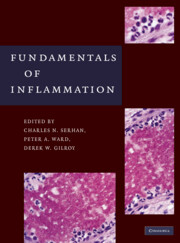Book contents
- Frontmatter
- Contents
- Contributors
- Preface
- PART I THE INFLAMMATORY RESPONSE – AN OVERVIEW
- PART II INDIVIDUAL CELL TYPES
- 4A Neutrophils I
- 4B Neutrophils II
- 5 Mast Cells as Sentinels of Inflammation
- 6 Basophils
- 7 Eosinophils
- 8 Macrophages
- 9 Lymphocytes
- 10 Fibroblasts and Stromal Cells
- 11 Neutrophil–Endothelial Cell Interactions
- PART III CHEMICAL MEDIATORS
- PART IV IMMUNOPHARMACOLOGY
- PART V INFLAMMATORY DISEASES/HISTOLOGY
- PART VI ANIMAL MODELS OF INFLAMMATION
- Index
- References
9 - Lymphocytes
from PART II - INDIVIDUAL CELL TYPES
Published online by Cambridge University Press: 05 April 2014
- Frontmatter
- Contents
- Contributors
- Preface
- PART I THE INFLAMMATORY RESPONSE – AN OVERVIEW
- PART II INDIVIDUAL CELL TYPES
- 4A Neutrophils I
- 4B Neutrophils II
- 5 Mast Cells as Sentinels of Inflammation
- 6 Basophils
- 7 Eosinophils
- 8 Macrophages
- 9 Lymphocytes
- 10 Fibroblasts and Stromal Cells
- 11 Neutrophil–Endothelial Cell Interactions
- PART III CHEMICAL MEDIATORS
- PART IV IMMUNOPHARMACOLOGY
- PART V INFLAMMATORY DISEASES/HISTOLOGY
- PART VI ANIMAL MODELS OF INFLAMMATION
- Index
- References
Summary
Lymphocytes are a type of white blood cell or leukocyte and are critical for the defense of the body against invaders such as infectious pathogens and foreign materials. There are approximately 1012 lymphocytes in the average human body, though this fluctuates considerably during illness. Indeed, fluctuation from a normal range is used as an indicator of disease. For example, immune deficiency leads to reduced lymphocyte numbers in the blood whereas infection or allergy leads to an increase. Several different types of lymphocyte exist, and though they display highly specialized and diverse functions, they all derive from a common hematopoietic stem cell in the bone marrow (Figure 9.1). Mature lymphocytes are found throughout the body: in the blood and lymphatic system; concentrated in immune specialized regions (lymph nodes, thymus, spleen, and Peyer's patches); and scattered in most other tissues.
Lymphocytes can be divided on the basis of size and granularity. Natural killer (NK) cells are large and highly granular, and there are two main types of small lymphocyte: B lymphocytes (or B cells) and T lymphocytes (or T cells). As we will see in this chapter, these are further subdivided based on their expression of different surface molecules, their secretion of different products important for immunity, and their ultimate effector function. B cells (so-called because they were originally identified in birds in the Bursa of Fabricius) are not only produced in the bone marrow but also mature there. However, the precursors of T cells leave the bone marrow and mature in the thymus (which explains the notation “T”).
- Type
- Chapter
- Information
- Fundamentals of Inflammation , pp. 107 - 125Publisher: Cambridge University PressPrint publication year: 2010
References
- 1
- Cited by



